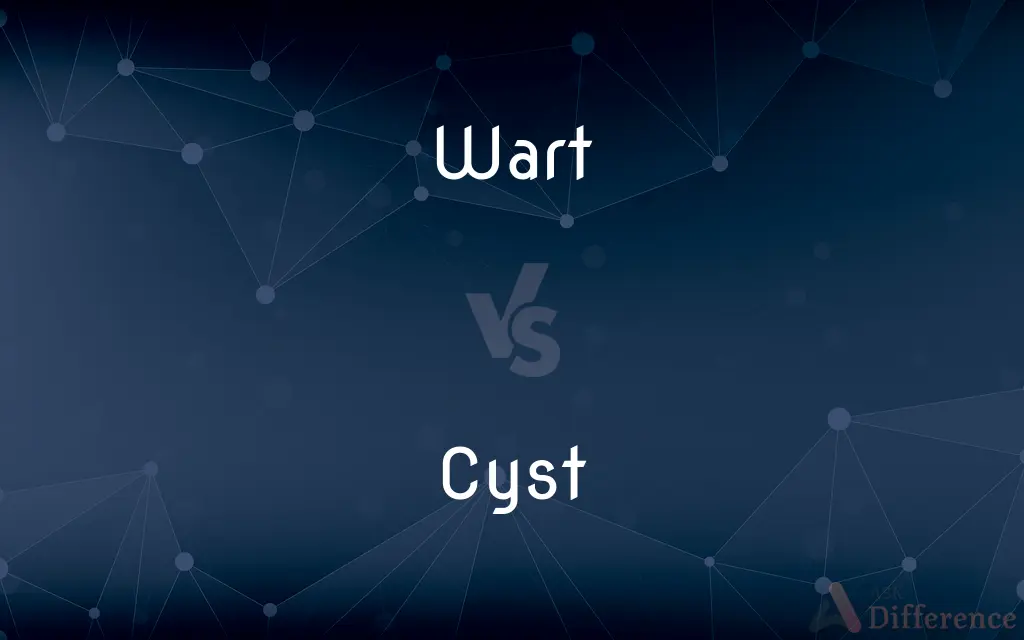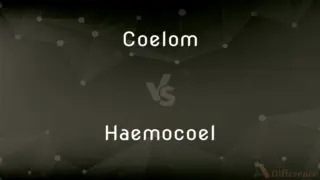Wart vs. Cyst — What's the Difference?
By Tayyaba Rehman & Fiza Rafique — Updated on April 15, 2024
Warts are skin growths caused by viruses in the human papillomavirus family, characterized by their rough texture; cysts are enclosed pockets of tissue that can contain fluid, pus, or other substances, often with a smoother appearance.

Difference Between Wart and Cyst
Table of Contents
ADVERTISEMENT
Key Differences
Warts are typically rough-textured growths that appear on the skin due to viral infections specifically from the human papillomavirus (HPV), whereas cysts are smoother, enclosed pockets that can form anywhere in the body and contain a variety of substances such as fluid or pus.
Warts are contagious and can spread through direct contact with the skin or shared use of items like towels or footwear, while cysts are not contagious and are usually caused by blockages of ducts, infections, or chronic inflammatory conditions.
The treatment for warts often involves topical treatments, freezing (cryotherapy), or surgical removal, depending on the wart's size and location. Cysts, on the other hand, may not require treatment unless they are painful, infected, or growing, in which case they might be drained or surgically removed.
Warts generally resolve on their own over time as the immune system fights off the virus, although this process can take years. Cysts may remain indefinitely if not surgically removed and can sometimes recur in the same location.
Diagnosis of warts is usually based on their distinctive appearance and location on the body, such as the hands, feet, or face. Cysts are often diagnosed using imaging studies like ultrasounds or CT scans to determine their content and precise location.
ADVERTISEMENT
Comparison Chart
Cause
Viral infection (HPV)
Blocked ducts, infections, genetic conditions
Texture
Rough
Smooth
Contagiousness
Contagious
Not contagious
Treatment
Freezing, topical treatments, removal
Watchful waiting, draining, removal
Recurrence
Possible, if virus remains
Can recur if not completely removed
Compare with Definitions
Wart
A common dermatological issue in both children and adults, easily spread in communal areas.
After using the public pool regularly, he developed a wart on his foot.
Cyst
A treatable condition that may require surgical intervention if symptomatic.
The cyst on her ovary was causing pain, so surgery was recommended.
Wart
A viral infection that can cause clusters of growths, especially on hands and feet.
The child had several warts on her hands that spread to other areas.
Cyst
A closed capsule or sac-like structure, typically filled with liquid, semisolid, or gaseous material.
The ultrasound showed a small cyst on her liver, but it was benign.
Wart
A rough-textured, often painful growth that can appear on various parts of the body.
He developed a painful wart on his toe after walking barefoot in the gym shower.
Cyst
A non-infectious, often painless growth that can occur under the skin or inside the body.
He had a cyst on his neck that grew larger over several months.
Wart
A benign growth that can be removed through cryotherapy or laser treatments.
She opted for cryotherapy to remove the persistent wart on her knee.
Cyst
A medical anomaly that can be detected through imaging tests like MRI or CT scans.
A CT scan was used to confirm the presence of a cyst in his abdomen.
Wart
A small, fleshy bump on the skin or mucous membrane caused by human papillomavirus.
She noticed a wart on her finger and decided to treat it with over-the-counter remedies.
Cyst
An abnormal pocket in the body that can sometimes cause discomfort if it becomes enlarged.
Her wrist cyst became painful, prompting a visit to the doctor.
Wart
Warts are typically small, rough, hard growths that are similar in color to the rest of the skin. They typically do not result in other symptoms, except when on the bottom of the feet, where they may be painful.
Cyst
A cyst is a closed sac, having a distinct envelope and division compared with the nearby tissue. Hence, it is a cluster of cells that have grouped together to form a sac (like the manner in which water molecules group together to form a bubble); however, the distinguishing aspect of a cyst is that the cells forming the "shell" of such a sac are distinctly abnormal (in both appearance and behaviour) when compared with all surrounding cells for that given location.
Wart
A hard rough lump growing on the skin, caused by infection with certain viruses and occurring typically on the hands or feet.
Cyst
An abnormal membranous sac in the body containing a gaseous, liquid, or semisolid substance.
Wart
A similar growth or protuberance, as on a plant.
Cyst
A sac or vesicle in the body.
Wart
A genital wart.
Cyst
(Biology) A small capsulelike sac that encloses certain organisms in their dormant or larval stage.
Wart
One that resembles or is likened to a wart, especially in unattractiveness or smallness.
Cyst
(Botany) A thick-walled resting spore, as in certain algae or fungi.
Wart
An imperfection; a flaw.
Cyst
A pouch or sac without opening, usually membranous and containing morbid matter, which develops in one of the natural cavities or in the substance of an organ.
Wart
(pathology) A type of deformed growth occurring on the skin caused by the human papillomavirus (HPV).
Cyst
(medicine) Of or pertaining to the urinary bladder or gall bladder (in compounds).
Cystectomy, cystitis, cystoscopy
Wart
Any similar growth occurring in plants or animals, such as the parotoid glands in the back of toads.
Cyst
A pouch or sac without opening, usually membranous and containing morbid matter, which is accidentally developed in one of the natural cavities or in the substance of an organ.
Wart
Any of the prefixes used in Hungarian notation.
Cyst
One of the bladders or air vessels of certain algæ, as of the great kelp of the Pacific, and common rockweeds (Fuci) of our shores.
Wart
A small, usually hard, tumor on the skin formed by enlargement of its vascular papillæ, and thickening of the epidermis which covers them.
Cyst
A small capsule or sac of the kind in which many immature entozoans exist in the tissues of living animals; also, a similar form in Rotifera, etc.
Wart
An excrescence or protuberance more or less resembling a true wart; specifically (Bot.), a glandular excrescence or hardened protuberance on plants.
Cyst
A closed sac that develops abnormally in some body structure
Wart
Any small rounded protuberance (as on certain plants or animals)
Cyst
A small anatomically normal sac or bladderlike structure (especially one containing fluid)
Wart
(pathology) a firm abnormal elevated blemish on the skin; caused by a virus
Common Curiosities
How are warts treated?
Treatments include topical solutions, cryotherapy, and surgical removal.
Are warts contagious?
Yes, warts are contagious and can spread through direct skin contact.
Can warts recur after treatment?
Yes, warts can recur if the virus remains in the skin.
How are cysts treated?
Some cysts require no treatment, others may be drained or surgically removed.
Can cysts become cancerous?
Most cysts are benign, but some types can become cancerous.
Where do warts commonly appear?
Warts commonly appear on the hands, feet, and face.
What is a cyst?
A cyst is a closed pocket of tissue that can contain fluid, air, or other substances.
What causes warts?
Warts are caused by the human papillomavirus (HPV).
Are cysts contagious?
No, cysts are not contagious.
What symptoms do cysts cause?
Cysts may cause no symptoms unless they become large, infected, or inflamed.
Share Your Discovery

Previous Comparison
Coelom vs. Haemocoel
Next Comparison
Plant vs. MachineryAuthor Spotlight
Written by
Tayyaba RehmanTayyaba Rehman is a distinguished writer, currently serving as a primary contributor to askdifference.com. As a researcher in semantics and etymology, Tayyaba's passion for the complexity of languages and their distinctions has found a perfect home on the platform. Tayyaba delves into the intricacies of language, distinguishing between commonly confused words and phrases, thereby providing clarity for readers worldwide.
Co-written by
Fiza RafiqueFiza Rafique is a skilled content writer at AskDifference.com, where she meticulously refines and enhances written pieces. Drawing from her vast editorial expertise, Fiza ensures clarity, accuracy, and precision in every article. Passionate about language, she continually seeks to elevate the quality of content for readers worldwide.














































